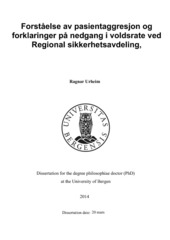Forståelse av pasientaggresjon og forklaringer på nedgang i voldsrate ved Regional sikkerhetsavdeling, Sandviken sykehus
Doctoral thesis
Permanent lenke
https://hdl.handle.net/1956/7907Utgivelsesdato
2014-03-20Metadata
Vis full innførselSamlinger
Sammendrag
A reduced amount of violence in a regional high security psychiatric ward - what happened and how to describe main dimensions of patient aggression? This thesis is based on 17 years of clinical data and experience from a forensic high security psychiatric ward. While description of violence rate in general points to large cultural and historical variation and considerable diversity in expression, the literature on psychiatric inpatient violence rate is sparse and mainly treats aggression as a homogenous phenomenon. Firstly, the aim of the thesis is to describe changes in ward variables during a period of 18 years and to apply these in exploring plausible explanatory variables for the observed reduction in violence rate during the middle part of this period. Secondly, in order to gain a more comprehensive understanding of patient aggression we also tested a 3-factor model of motivations for violent behaviour in inpatients in a forensic high security unit. Firstly, using historical-documentary methods, we documented a change in regime during the observation period of 17 years, allowing increased patient autonomy. This co-occurred with changes in ward staff and quality of treatment methods. Staff with experience from this part of the 17-year period, were interviewed about their explanations of the decline in violence rate. They suggested several explanatory variables for this decrease, whereof some of them addressed contextual factors. These where then formally tested by visually comparing the development in each suggested variable with the development in inpatient violence. This approach falsified some of the suggested explanations. Among those not falsified, introduction of procedures of post-incident interviews and increased ratio of female staff were the most frequent mentioned. Secondly, a common feature of the suggestions was more individualized treatment of patients. Confirmatory factor analysis of data based on staff s evaluations of incidents supported the 3-factor model of patient aggression with factors for irritable, instrumental and defensive aggression. Irritable was the most prevalent type of aggression in this context, followed by instrumental and defensive. The findings indicate that transforming a restrictive ward regime into allowing more patient autonomy quality of treatment can co-occur with reduced inpatient violence, but the research design does not allow us to conclude about causal relationship. Other variables suggested by experience clinicians to be relevant explanatory factors for the reduced violence incidence are staff qualities, improved management of risk situations and violence, promoting staff-patient cooperation, and more individualized treatments. All these factors changed at the time of the reduced violence incidence, and can thus have caused the reduced incidence of violence.
Består av
Paper I: Urheim R, Palmstierna T, Rypdal, K and Mykletun A. Patient Autonomy versus Risk Management: A Case Study of Change in a High Security Forensic Psychiatric Ward. International Journal of Forensic Mental Health, 2011; 10(1), 41-51. The article is not available in BORA due to publisher restrictions. The published version is available at: http://dx.doi.org/10.1080/14999013.2010.550983Paper II: Urheim R, Palmstierna T, Rypdal K and Mykletun A. Explanations for reduced violence in a high security forensic psychiatric ward. The article is not available in BORA.
Paper III: Urheim R, Rypdal K, Melkevik O, Hoff H, Mykletun A and Palmstierna T. Motivational dimensions of inpatient aggression. Criminal Behaviour and Mental Health, 2014; 24(2), 141-150. The article is not available in BORA due to publisher restrictions. The published version is available at: http://dx.doi.org/10.1002/cbm.1894
